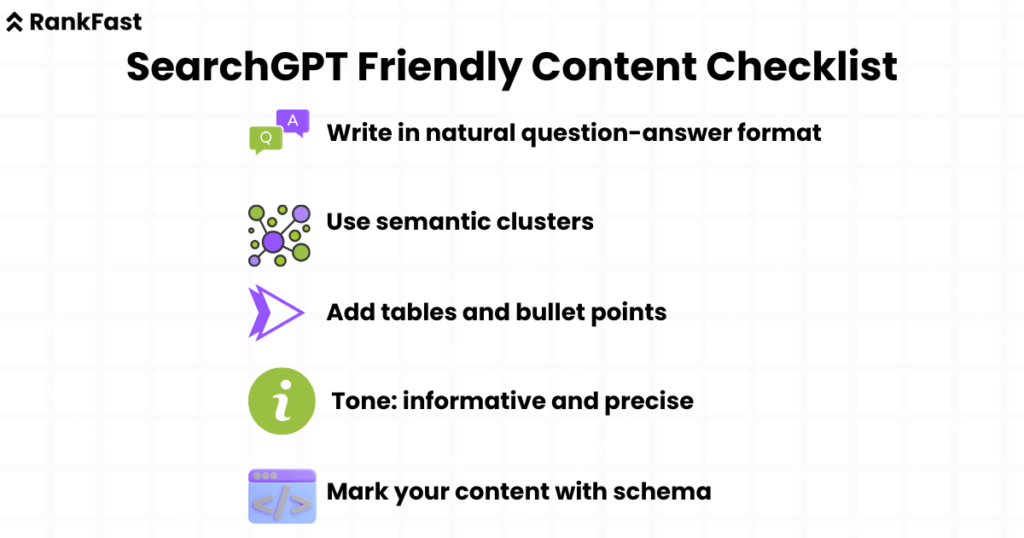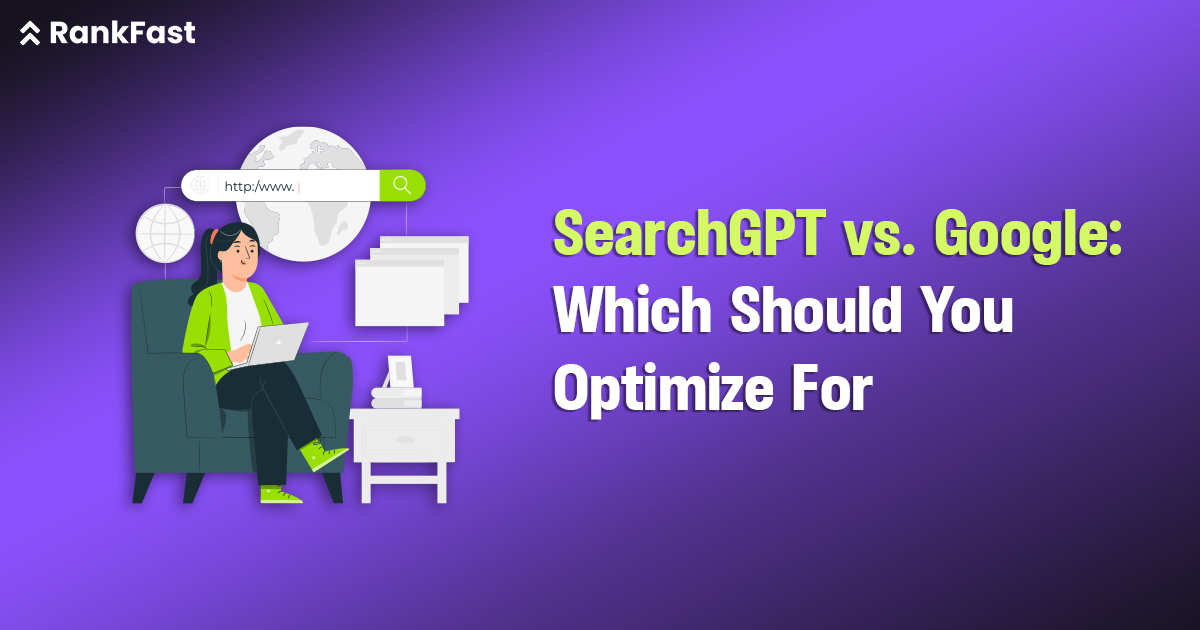Why do some pages rank high without backlinks while others with great content get buried? Many marketers don’t realize that Google vs SearchGPT isn’t just a buzzword. It’s real, and it’s changing how we create content. The old SEO tricks? They still matter, but only on one side.
As of May 2025, Google holds 89–90% of the global search engine market share, but that grip is slipping. In this blog, we’ll explore how to write content that wins on both platforms.
What is SearchGPT?
SearchGPT is not a traditional search engine. It’s an AI-powered answer engine. When users ask a question, it doesn’t list links. It generates one answer. No scrolling. No ten blue links. That’s a massive shift from how Google search works.
This model doesn’t rely on backlinks or domain authority. It picks the best-fit content from millions of documents using natural language understanding. If your content isn’t clear, contextual, and structured? You’ll lose visibility.
Most businesses today don’t realize that they’re competing in two separate search economies: SearchGPT vs. Google. Optimizing only for one means missing half the audience. If your product solves queries like “best mutual fund for SIP in 2025,” and it’s not formatted the way SearchGPT understands, you’ve already lost that user.
Also, voice and chat-based tools are growing fast. Most Gen Z users don’t even Google things anymore, they just ask a bot. If your brand’s knowledge graph isn’t ready for that, you’re invisible.
How Does Google Search Work in 2025?
Google search in 2025 is still based on crawling and indexing pages. It looks at relevance, backlinks, freshness, keyword usage, and over 200 signals. But there’s one major update: AI is now a part of how results are ranked and displayed.
That’s where things get tricky.
Earlier, you only needed solid backlinks and a good content structure. Now, Google also tries to summarise answers using its own AI models. That means you’re not just competing with websites, you’re competing with Google’s own AI.
Rich snippets, People Also Ask, and Featured Snippets, all now sometimes show answers written by AI models, not just pulled from sites. The search engine still ranks links, but the zero-click searches have increased.
Google vs SearchGPT is no longer about who gives better answers, it’s about who gives faster answers. Google still owns the search journey, but the end-point? That’s where SearchGPT comes in.
Here’s an example:
Search: “best phone under 20k”
- Google: 10 links, shopping ads, YouTube videos, and a listicle.
- SearchGPT: One direct answer with 3 recommendations and reasons.
Gartner now predicts a 25% drop in traditional search volumes by 2026. Even though Google search vs. SearchGPT still overlap, the experience and user trust paths are different now.
Key Differences Between SearchGPT and Google
In SearchGPT vs Google, one is reference-based, and the other is generation-based. That’s a massive gap in how your content must be planned. If you’re still just updating old blog posts with keywords, you’re doing it wrong.
Google search vs. SearchGPT will force marketers to build two versions of the same idea, one for ranking and one for answering. Most don’t do that yet.
| Feature | SearchGPT | |
| Type | Search Engine | AI Answer Engine |
| User Journey | Click-through journey via multiple links | Direct answer in chat or voice format |
| Ranking Factors | Backlinks, keywords, Core Web Vitals | Clarity, structure, semantic matching |
| Display Style | List of pages, snippets, ads | Direct paragraph-style responses |
| CTR Strategy | Title, meta tags, structured data | Clear headings, bullets, factual depth |
| Update Frequency | Regular algorithm updates | Frequent model training updates |
| Optimization Focus | Technical SEO, On-page SEO, backlinks | NLP-friendly structure, question-answer pairs |
| Language Support | 100+ languages | High performance in major global languages |
Also read: SearchGPT Is Replacing Google? SEO Will Never Be the Same!
Content Optimization for SearchGPT
You don’t optimize for SearchGPT the way you do for Google. Forget keyword stuffing. Forget writing 2000 words of fluff. What matters is relevance, structure, and clarity.
Here’s what works:

1. Write in natural question-answer format
Break your content into logical, compact blocks. Use subheadings like:
- What is X?
- How does Y work?
- Is Z better than A?
These increase your chances of getting picked up by SearchGPT’s content filter.
2. Use semantic clusters
Instead of repeating the same keyword, write around the topic. Example:
Main Topic: Mutual Funds
Cluster: SIP returns, ELSS vs PPF, Risk types, 2025 tax rules.
This gives context, which SearchGPT understands better than keywords.
3. Add tables and bullet points
AI engines parse content faster in tabular or list formats. Use them in each section.
4. Tone: Informative and precise
Avoid jokes, fluff, or vague advice. Clarity beats creativity in SearchGPT vs. Google.
5. Mark your content with schema
Even though SearchGPT doesn’t use HTML directly, schema tells LLMs what the page is about. Use FAQ, HowTo, and Product schemas wherever possible.
Most people miss this: Optimising for SearchGPT is not about pleasing bots, it’s about answering people. Clearly. Quickly.
Content Optimization for Google
Google hasn’t changed its core DNA, but it has evolved. Here’s how to win:
1. Nail technical SEO
Ensure fast loading speed, mobile-friendly design, clean URLs, proper headings, canonical tags, and image alt tags. No negotiation here.
2. Focus on E-E-A-T
Google now gives more weight to Experience along with Expertise, Authority, and Trust. Show reviews, credentials, author bios, and first-hand usage.
3. Create depth, not fluff
Don’t write to reach 2000 words. Instead, write so the user doesn’t need to visit another page.
4. Build backlinks with intent
Links still work. But not all links. Earn links from related pages, not random domains.
5. Use structured data
Google crawlers rely heavily on the schema to identify content types. FAQPage, Article, Review, Product, use them as needed.
6. Update often
Google loves fresh pages. If your blog hasn’t changed in 2 years, it’s dead weight.
7. Reduce bounce
Design for the scroll. Use jump links, TOCs, and visual anchors to keep users from bouncing.
In the SearchGPT vs. Google debate, Google still wants pages it can rank by logic. Not intuition.
Which Platform Should You Optimize For?
Both. But not equally.
If you sell, teach or explain? Lean towards SearchGPT.
If you build a brand, grow traffic, and convert? You still need Google.
Here’s a simple rule:
- Informational content: Focus on SearchGPT
- Commercial content: Focus on Google
Still, don’t pick sides blindly. Google search vs. SearchGPT is a false binary. Both feed each other. SearchGPT may surface your brand, but users may Google you later.
So, optimize content for both. One gets your attention, the other closes the sale.
Actionable Tips to Optimize for Both
- Write content in layers: Answer directly, then add depth.
- Use short paragraphs, clear subheadings, and bullet points.
- Always ask: can this answer work in voice?
- Target question keywords: “how to,” “what is,” “vs,” and “best ways to.”
- For each topic, create a long article + a short explainer.
- Add internal links across both versions.
- Use real data, stats, and examples.
- Create visuals that can be parsed: charts, and comparison tables.
- Write clearly enough for a class 10 student, smart enough for a CXO.
- Stay updated with both platforms’ evolution.
You can’t afford to miss either side in the SearchGPT vs. Google war.
Final Thoughts
The game has changed. You can no longer write only for Google or only for AI. You must do both. Content without structure won’t win on SearchGPT. Content without links won’t win on Google. Smart marketers will learn to balance both.
At Rankfast, we help brands create content that works across both engines. Want to future-proof your content? Let’s talk.
FAQs
1. Is SearchGPT a search engine like Google?
No. SearchGPT is an AI answer engine. It gives direct answers, not links.
2. Can my blog rank in both Google and SearchGPT?
Yes. But you must format it for both platforms. That means structure and context.
3. Are backlinks needed for SearchGPT?
No. It looks at content quality, not backlinks or authority.
4. Should I still invest in SEO for Google?
Absolutely. Google is still the biggest traffic source globally.
5. How often should I update content?
Every 6–12 months. Freshness signals matter on both Google and SearchGPT.

Leave a Reply